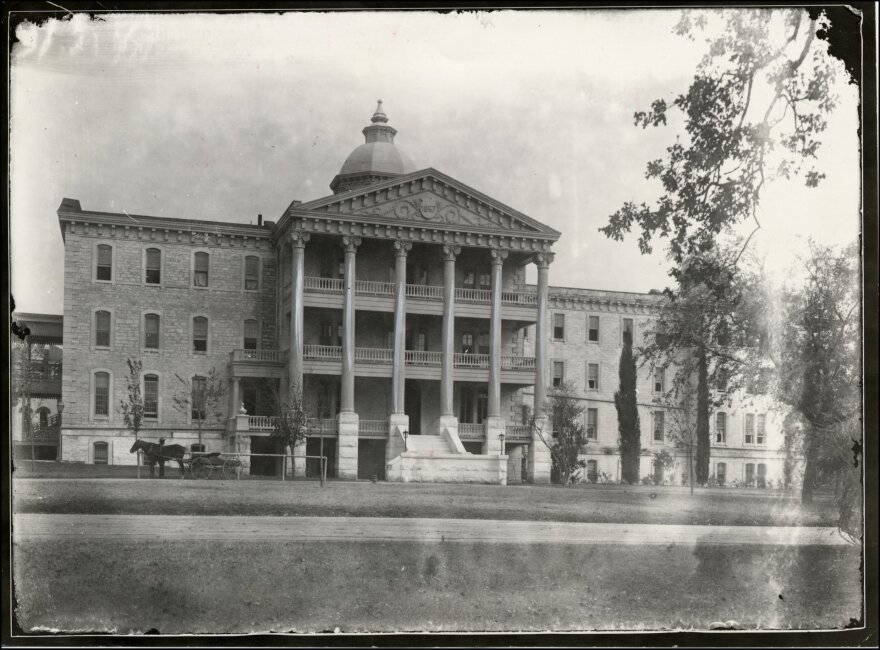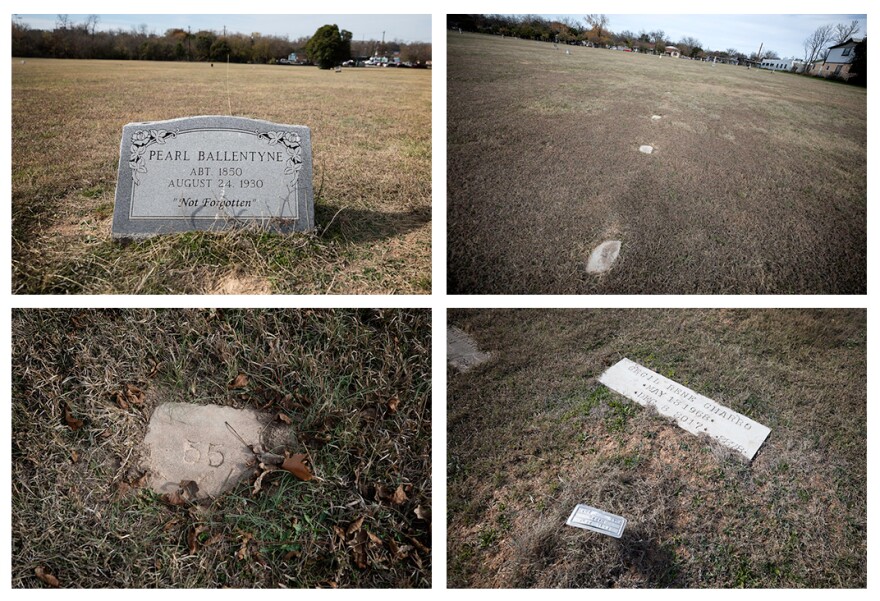This piece was originally performed during KUT's ATXplained Live show at the Paramount Theatre. Get tickets to our next live show on Oct. 11 here.
If you’re traveling along 51st Street in Austin, a few blocks east of Lamar, you’ll see a big field. Not the playing fields on the south side of the street; the one with the gravestones on the north side.
“I looked at it every time I drove by. And then at some point I noticed the gravestones, but there weren't very many,” says Julie Almendral, who asked about it for our ATXplained project.
A few dozen markers are visible from the street. There's a chain-link fence on all sides and a sign outside a wrought iron gate that reads: Austin State Hospital Cemetery.
“Who's buried here?" Almendral asked. "Will more people be buried here?”
SUBSCRIBE | Get the ATXplained podcast on Apple, Google or your favorite player
The Texas State Lunatic Asylum
To understand who is buried in the cemetery, we need to go back to 1861. That’s when the state opened a hospital for people with mental illness called (bluntly) the Texas State Lunatic Asylum.

The facility, which is still at Guadalupe and 41st streets, became home to hundreds of people with psychiatric illnesses (and presumably some who did not actually suffer from an illness).
“[It was] people who created a disturbance in the community because of their mental health issues, alcoholism. You know what we call depression today, bipolar disorder,” says Carl Schock, who was superintendent of the facility from 2000 to 2013. “All of those things were present. They just weren't called that.”
But there was little in the way of treatment for – or medical understanding of – these conditions. Many families could not care for relatives with these untreated conditions, so they went to the asylum.
“People would come to the hospital, they would be there for a lifetime."Carl Schock, former superintendent of Austin State Hospital
“The state actually institutionalized these people, which relieves the families of the burden,” says Dale Flatt, who founded a nonprofit called Save Austin's Cemeteries. “And in doing so, they created a whole system whereby people were just locked away.”
It wasn’t always like the asylums you might think of from the movies – dank dungeons where patients are abused. There was clearly a range of patient experiences. The facility was segregated, so the care you got also likely depended on the color of your skin. But from all accounts, it wasn’t a prison. Patients were required to stay, of course, but the asylum was part of the neighborhood developing around it.
“People from Hyde Park would come to the hospital and play games with the patients out in the park areas,” Schock says. Neighbors would picnic on the facility’s grounds, which in those days, were quite scenic. There was a farm. It had its own water supply; it was a nearly self-sustaining village.
But with no real treatments, patients were there for years.
“People would come to the hospital, they would be there for a lifetime,” Schock says. “They would die and they may not have family that wanted them or family that could afford to bury them.”
So, the state did it.
The Original Cemetery
At first, patients who died at the asylum with no family – or no family willing – to make funeral arrangements were buried on the grounds outside the main building. Dozens were buried there until expansion work began in 1882.
That’s when workers exhumed the bodies and moved them to a new cemetery on 51st Street.
But the records of who was buried and where were not great. The graves were poorly marked. Some may have had wooden markers that disintegrated over time. At some point, the cemetery began using concrete markers with no names – just a number.


“The reason they put the numbers out there was to protect the identity of the people,” Flatt says. “So the average person walking by couldn't possibly make some associations.”
That is, they would not know if someone’s family member had been a patient at the asylum.
But this, in effect, doomed lots of those people to obscurity. Many of the records have been lost, so we don’t know who is buried there.
Less Funding, More 'Treatments'
As the years went on, the asylum grew, and so did the cemetery. The 1918 flu pandemic hit the hospital hard. At least a dozen people were buried in the cemetery that year.
In 1925, the facility was renamed the Austin State Hospital. The name sounded more humane, but life at the hospital was getting less humane.
“It was really only in the early 1900s, moving into the '40s and '50s, when funding became so strapped that the state hospitals kind of became those pits,” Schock says, like the ones in the movies.
Buildings were neglected. The hospital became more isolated from the community. The lakes on the grounds were drained. Patients were more restricted in what they could do and where they could go.
Then there were the new “treatments.”
“You know, lobotomies, seizure therapy," Schock says. "Looking back now, what we consider to be pretty barbaric types of treatments, but they were really doing the best they could at the time to control some symptoms of these folks."
But by the '60s, something happened that changed everything: the discovery of antipsychotic medications. It meant that facilities like ASH didn’t have to be a place where so many people spent a lifetime – or more.
“That led to a deinstitutionalization process that really started in California and moved across the country,” Schock says.
There was a period when there were more than 3,000 patients at the Austin State Hospital at any given time. Today that’s down to about 250, and the average stay is five months.
Of course, the state’s mental health infrastructure still has many problems and many critics, but I think we can all agree that not having thousands of people locked away with treatable illnesses is progress.
'Not Forgotten'
My mind keeps going back to the people in the cemetery with only a number to mark their graves. No one is going to remember them; it's as if they were never here.
About 20 years ago, there was someone who wanted to fix that. He was the maintenance director at the hospital, and his name was Dave Rupe.
“He just wanted to know … what is this cemetery about? What's the history?” Schock says. "Let's find out."
Rupe turned identifying the folks in the ASH Cemetery into kind of an obsession. He combed through patient records and logbooks. He made a database of the names and locations of all the people he could identify.
Maybe most importantly, he made sure anyone who was buried there after 1998 had not just a number, but a name on their headstone, too.
Rupe himself died in 2012.
EXPLORE | A database of the names of people known to be buried at the ASH Cemetery
All of this is a long answer to Almendral's question.
There are about 2,700 people buried at the Austin State Hospital Cemetery, but we don't know who they all are. Rupe was able to find the names of all but 600. We also don’t know exactly which plot each person is buried in. A few are famous; most are unknown.
John Neely Bryan, who founded the city of Dallas, is buried there, but we don’t know exactly where.

People do still get buried there, though just a few each year. Many are residents of the Austin State Supported Living Center, a residential facility for people with intellectual disabilities.
As for what will happen to the cemetery, now in the middle of a desirable neighborhood: It’s probably not going anywhere soon. Schock says developers approached him during his time as superintendent, but they lost interest when they found out thousands of people were buried there.
There was something else Schock said that stuck with me: “Part of society is how do we deal with people who die, who are otherwise unwanted.”
It says something about the rest of us when we let others pass into obscurity, especially people who struggled in life. And being institutionalized is a struggle many of us can’t even imagine.
“I think it's just important to remember that – there, by the grace of God, go I,” Schock says. “Any of us can be dealing with mental health issues and these people lived and died in the Austin community, and we need to remember that.”
The Austin State Hospital is undergoing a huge redevelopment that will make it unrecognizable to anyone there 100 years ago.
As for the cemetery, there have been some ideas to improve it: a new fence, proper gravestones, a memorial statue to honor the hundreds of unknowns buried there. But those ideas have mostly gone nowhere.
When there’s barely enough to care for the living, it’s hard to raise money for the dead.
Got a tip? Email Matt Largey at mlargey@kut.org. Follow him on Twitter @mattlargey.
If you found the reporting above valuable, please consider making a donation to support it. Your gift pays for everything you find on KUT.org. Thanks for donating today.











